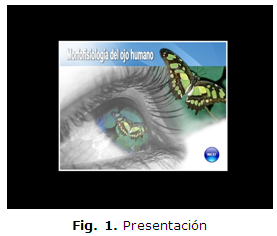Software educativo Morfofisiología del ojo humano

Resumen
I
Introducción: el desarrollo acelerado tecnológico ha dado surgimiento a las Nuevas Tecnologías de la Información y las Comunicaciones con implicaciones en la enseñanza de la medicina en Cuba, que se ajusta a la inserción del egresado en la comunidad, para desarrollar acciones de salud y brindar servicios médicos de calidad, en especialidades como la oftalmología.
Objetivo: diseñar un software educativo para la enseñanza y aprendizaje de las características morfofuncionales del órgano de la visión que tribute al modo de actuación de los estudiantes de primer año de medicina de la Facultad de Ciencias Médicas del Este de la Habana.
Material y método: de corte pedagógico de los resultados de promoción de la asignatura Morfofisiología III. Se utilizaron métodos teóricos, empíricos, materialista dialéctico y estadísticos. El universo y la muestra estuvo conformada por profesores de: informática, especialistas en Medicina General Integral y Ciencias Básicas.
Resultados: resultó necesario perfeccionar los medios de enseñanza y lograr una concepción científica del mundo utilizando los avances de las nuevas tecnologías. El software consta de varios módulos, en los que se presentan contenidos morfofisiológicos esenciales y enfermedades oculares más frecuentes y de mayor importancia para la formación del médico general.
Conclusiones: el software constituye un aporte novedoso al proceso enseñanza aprendizaje del órgano de la visión. Tributa al modo de actuación del futuro egresado, mediante la formación de valores, interactividad con el contenido, retroalimentación, evaluación, y el desarrollo de habilidades como el trabajo independiente y autopreparación utilizando los modernos medios de enseñanza.
Palabras clave
Referencias
Mejías Sánchez Y, Duany Machado OJ, Toledo Fernández Am. Cuba y la cooperación solidaria en la formación de médicos del mundo. Rev. Educación Médica Superior. 2010; 24(1):4-20.
Marquès P. Posibilidades de las TIC en educación especial. [Internet]. 2011 [Consultado10.02.2012]. Disponible en: http://www.peremarques.pangea.org
Rodríguez Cortés V, del Pino Sánchez E. Proceso docente educativo: una visión para el profesor de la asignatura de Morfofisiología Humana (I). Educ Med Super. 2009; 23(3):13-8.
Fernández Pérez J, Reyes Reyes S, Blasco Carratalas A. Farmacología. CápII. En: Alañón Fernández FJ, Fernández Pérez J, Ferreiro López S. Oftalmología en atención Primaria. Madrid: Formación Alcalá; 2001: 47.
Vidal M, Gómez F, Ruiz M. Software educativos. Educ Med Super. [revista en la Internet]. 2010 Mar [citado 18 Abr 2010 ];24(1):97-110. Disponible en: http://scielo.sld.cu/scielo.php?script=sci_arttextpid=S0864-21412010000100012lng=es
Vidal M, Nolla N, Diego F. Plataformas didácticas como tecnología educativa. Educ Med Super[revista en la Internet]. 2009 [citado 11 Nov 2009]; 23(3) Disponible en: http://bvs.sld.cu/revistas/ems/vol23_3_09/ems13309.htm
Clark RE. Five Common but Questionable Principles of Multimedia Learning. En: Clark. The Cambridge Handbook of Multimedia Learning. Cambridge: Cambridge University Press; 2009: 90-4.
O'Farrill E. El Centro de Cibernética Aplicada a la Medicina, estrategia: 1985-1995. Cuba. Revista Cubana de Informática Medica. [Internet]. 2007 [citado 2008 May 15]; (1): [Aprox. 10 p.] Disponible en: http://www.rcim.sld.cu/revista_12/articulos_htm/estrategiacecamdos.htm
Lombillo Rivero I. La utilización de los medios de enseñanza y las tecnologías de la información y la comunicación en la nueva universidad universalizada. ¿Una relación dinámica? Revista Pedagogía Universitaria [Internet] 2006 [Citado 2009 Mar 02]; 11(3): [Aprox. 20 p.] Disponible en: http://cvi.mes.edu.cu/peduniv/index.php/peduniv/article/view/375/366
Area M. Introducción a la tecnología educativa. Universidad de La Laguna. [Internet]. 2009 [Consultado15.03.2012]. Disponible en: http://webpages.ull.es/users/manarea/ebookte.pdf
Rodríguez Morell JL. Universalización, internacionalización y educación multicultural: hacia un nuevo paradigma de la Universidad Cubana contemporánea. Revista Cubana de Educación Superior. 2006; 26(2): 113-9.
Wong Orfila T, Gutiérrez Maydata A, Díaz Velis Martínez E. Alternativas metodológicas para el establecimiento de la vinculación básico-clínica de la anatomía en la carrera de Medicina. Educ Med Super [Internet]. 2007 Jun [citado 2014 Mar 01]; 21(2): [Aprox. 9 p.] Disponible en: http://scielo.sld.cu/scielo.php?script=sci_arttextpid=S0864-21412007000200005lng=es
Almeida Campos S. La universalización de las Ciencias Médicas. Un nuevo reto a la enseñanza médica cubana. Memorias de la Convención Internacional [CD-ROM]. La Habana: Universidad; 2006.
Copyright (c) 2014 Dianelys León Medina

Esta obra está bajo una licencia de Creative Commons Reconocimiento-NoComercial-CompartirIgual 4.0 Internacional.




 La revista está: Certificada por el CITMA
La revista está: Certificada por el CITMA